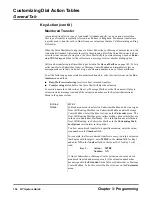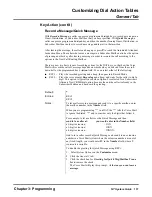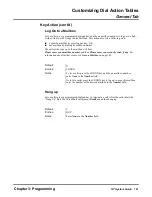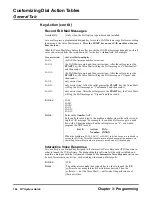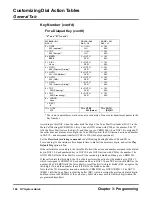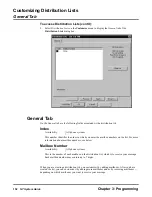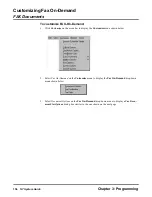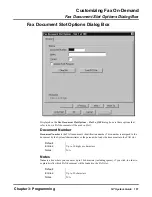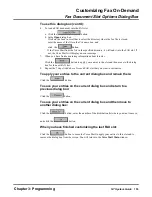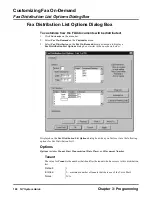
Customizing Dial Action Tables
General Tab
Chapter 3: Programming
NT System Guide
145
Key Number
The Key Number in a DAT identifies the target of the Key Action. The target is the place to which
the call is transferred after the Voice Mail performs the specified Key Action. The place may be a
mailbox, extension, or the Automated Attendant.
For a Dialpad Key
For any dialpad key 0
–
9, *, or #, the Key Number may be either a specific mailbox, such as
367, or a representation of how the target location is configured. For example: Suppose you
are programming a DAT for a Voice Mail system where every 3-digit extension begins with the
digit 1, and you want to transfer the call to an extension when the caller dials a “1.” You would
set up Key 1 in the DAT to read:
Key 1: Action: TRF
Number: XXX
XXX is the length in digits of the mailbox number where the call will be transferred.
None is the usual Key Number setting for the LOGON, DIRF, and DIRL Key Actions. When
combined with these entries, the None tells the Voice Mail that the Key Number has not been
programmed yet. In these cases, the Voice Mail needs to ask for more information about where
to transfer the call after performing the Key Action. For a LOGON, the Voice Mail needs to
know the number of the mailbox where the caller wants to log on. For a DIRF, the Voice Mail
needs to know the first few letters of the mailbox owner’s first name. For a DIRL, the Voice
Mail needs to know the first few letters of the mailbox owner’s last name.
(For more information about LOGON, see Log On to a Mailbox on page 141. For more infor-
mation about DIRFs and DIRLs, see Directory Dialing by First/Last Name on page 138. )
“Z” and “R” for Drop-and-Retrieve Operations
“Z” and “R” are special entries in the Number field of a DAT. These entries work together in
order to tell the Voice Mail how to perform a drop-and-retrieve operation. The “Z” causes the
Voice Mail to store a caller-dialed digit. The “R” causes the Voice Mail to retrieve and input the
caller-dialed digit that has been stored by the “Z.”
What these entries mean is easy to understand, but why and how they are used in a DAT
requires a more detailed explanation. You often place “Z” and “R” in a DAT in order to resolve
cases of conflicting transfer targets. These are situations where the Voice Mail may transfer the
call to either of two different places in response to one caller-dialed digit. As an instance of this
problem: Callers into a certain Voice Mail system might dial the digit 2 to reach both the Sales
department and any extension number beginning with a 2, such as 235.
The table on the next page shows how you might set up a DAT with “Z” and “R” entries, so
that dialing a 2 in this example would cause the Voice Mail to perform effectively the type of
call transfer intended by the caller.
Availability:
All phone systems unless otherwise noted.
Summary of Contents for NVM-NT
Page 28: ...Table of Contents Chapter 5 Maintenance xxvi NT System Guide ...
Page 130: ...Installing SMDI 102 NT System Guide Chapter 3 Programming ...
Page 146: ...Customizing Caller I D Tables General Tab 118 NT System Guide Chapter 3 Programming ...
Page 156: ...Customizing Callout Options Optional Tab 128 NT System Guide Chapter 3 Programming ...
Page 182: ...Customizing Distribution Lists General Tab 154 NT System Guide Chapter 3 Programming ...
Page 338: ...Customizing Port Options General Tab 310 NT System Guide Chapter 3 Programming ...
Page 358: ...Customizing System Options Timers Tab 330 NT System Guide Chapter 3 Programming ...
Page 362: ...Customizing System Options Timers Tab 334 NT System Guide Chapter 3 Programming ...
Page 367: ...Customizing Tenant Options General Tab Chapter 3 Programming NT System Guide 339 ...
Page 396: ...Viewing and Printing Reports System Options Report 368 NT System Guide Chapter 3 Programming ...
Page 400: ...Performing a Local Backup Backup Dialog Box 372 NT System Guide Chapter 3 Programming ...
Page 440: ...Using Port Activities 412 NT System Guide Chapter 3 Programming ...
Page 454: ...Using Message Status Message Status Dialog Box 426 NT System Guide Chapter 3 Programming ...




